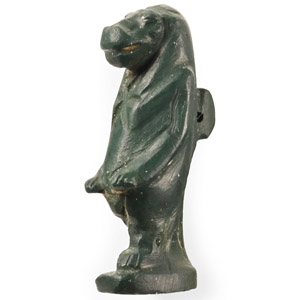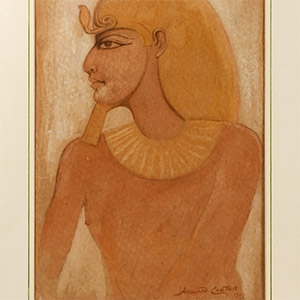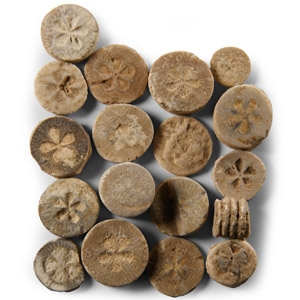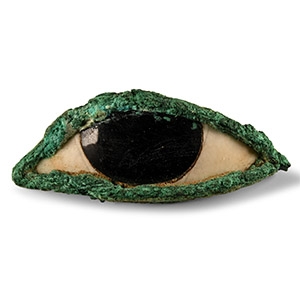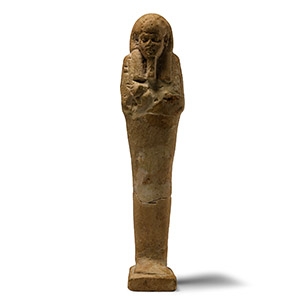Home > Auctions > 4 June - 8 June 2024
Ancient Art, Antiquities, Natural History & Coins
Auction Highlights:
From an old English deceased estate.
Acquired on the London art market in the early 1990s.
Property of a London, UK, collector.
From a collection acquired on the UK art market from various auction houses and collections mostly before 2000.
From an important Cambridgeshire estate; thence by descent.
Cf. von Droste zu Hülsdorf, V. and Schlick-Nolte, B., Ägyptische Bildwerke II: Statuetten, Gefässe und Geräte, Melsungen, 1990, pp.308-309, no. 189, for a similar bronze figurine.
Sekhmet was a ferocious and aggressive deity, the consort of Ptah, and closely associated with the king. An amulet would imbue its wearer with her power.
Ex London, UK collection, 1990s.
Cf. Matouk, F.S., Corpus du scarabée égyptien. Vol. 2: Analyse thématique, Beirut, 1976, p.345, no.584, for the baboon and Bes motif.
Bes became one of ancient Egypt's most popular apotropaic deities from the New Kingdom onwards. Despite his somewhat fearful appearance, Bes was the patron and protector of pregnant women and children and believed to protect the wearer from snakes. The depiction of baboons flanking Bes with their arms raised before the sun disk was a common feature on temple wall reliefs. In ancient Egyptian religious literature, baboons heralded the dawn and, thus, the rebirth of the sun.
Old French collection.
Acquired from Hotel des Ventes, Drouot, Paris, France, early 2000.
From the collection of Mr D.
Property of a French collector.
Cf. Andrews, C., Amulets of Ancient Egypt, London, 1994, plate 95.
The headrest, or weres amulet, was placed under the mummy's head to protect it from damage and ensure the deceased's rebirth.
Left Amulet: Brought by missionaries in the 19th century. Acquired in 1962. Ex Haeberlin collection. From a North German private collection E.S. with Gorny Mosch, Munich, Germany, 16 December 2015, 828 (Part)
Right Amulet: From the collection of Doctor Girard, a collector for over 60 years. with Hotel des Ventes de Clermont-Ferrand, 22 May 2017. Property of a French collector.
From the collection of Doctor Girard, a collector for over 60 years.
with Hotel des Ventes de Clermont-Ferrand, 22 May 2017.
Property of a French collector.
Cf. Andrews, C., Amulets of Ancient Egypt, London, 1994, pl.39(b).
The goddess Tawaret was a female hippopotamus with the arms and legs of a lion and the back and tail of a crocodile. Despite her fearsome appearance, Tawaret was a household deity and protector of women in childbirth.
with old Phillips label to the verso.
Cf. Davis, T.M., The Tomb of Hâtshopsîtû, London, 1906, plate facing p. 22, for Howard Carter's version of the same image produced for Theodore M. Davis' publication of Hatshepsut's tomb.
Hatshepsut was the longest-reigning female ruler in Egyptian history (1473-1458 B.C.), who undertook several military expeditions. Howard Carter's father, Samuel, was an illustrator for the Illustrated London News in the later 1800s. In 1891, Howard Carter accompanied Percy Newberry on an expedition focussing on First Intermediate Period tombs at the Middle Egyptian site of Beni Hasan, from which many of his original pieces survive. During his time at El-Amarna, the excavator Flinders-Petrie took Carter to visit the newly discovered royal tomb of Pharaoh Akhenaten. Carter made some sketches there which were published in The Daily Graphic on March 23, 1892, accompanying Petrie’s article on the tomb. These sketches were the first Egyptian drawings published by Howard Carter, and the first to convey the uniqueness of Amarna art to the European public.
From a central London ADA dealership, 1980-1990.
From an old English deceased estate.
Acquired on the London art market in the early 1990s.
Property of a London, UK, collector.
Ex AB collection, 1920s-1930s.
Accompanied by an old collection ticket.
Cf. Lacovara, P., Teasley Trope, B., and D’Auria, S.H., The Collector’s Eye: Masterpieces of Egyptian Art from The Thalassic Collection, Ltd., Atlanta, 2001, p.120, no.70, for similar inlaid eyes with faience frames.
Mummy masks were used as a protection over the deceased and were first introduced during the First Intermediate Period. The eyes were thought to fend off evil by reflecting it back to the one bestowing it.
Ex Mariaud de Serres, Paris, France, 1980-1990s.
From a London, UK, collection.
Cf. Manley, B., and Dodson, A., Life Everlasting. National Museum of Scotland Collection of Ancient Egyptian Coffins, Edinburgh, 2010, p.114, no.43, for a bead-work shroud incorporating the mask, winged scarab, and Four Sons of Horus.
The Four Sons of Horus were deities responsible for protecting the internal organs of the deceased. The human-headed Imsety protected the liver, the baboon-headed Hapy protected the lungs, the jackal-headed Duamutef protected the stomach, and the falcon-headed Qebehsenuef protected the intestines.
Ex M.S. Ciappara collection, Norfolk, UK, 1939-1950.
Cf. Janes, G., The Shabti Collections 6: A Selection from the World Museum, Liverpool, Lymm, 2016, 475-476, no. 248, for examples of similar style and text arrangement.
Shabti figures were created to carry out heavy manual tasks on behalf of a person in the afterlife. The body of a shabti was usually in the form of a mummy and often depicted with tools in their hands, such as baskets, picks, and hoes. During the Late Period, it was customary to be buried with hundreds of shabtis.
337 - 348 of 2809 LOTS

.jpg)

.jpg)
.jpg)
.jpg)
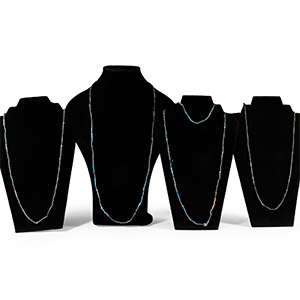



.jpg)
